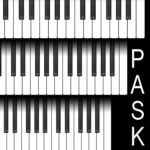Comparative keyboard studies
Use of alternatively sized keyboards* in research is a very new field of activity, but important results have emerged from research teams in the US and Australia.
Wristen et al. (2006) conducted a pilot study of small-handed pianists – defined as having active 1-5 spans of 8 inches (20.3 cm) or less – that involved the use of electromyography to provide empirical data on physical ease. Measurements were taken of muscle loading, hand span, wrist flexion and extension, and radial and ulnar deviation during performance of specified musical excerpts. The trials involved playing a particular keyboard, structured practice sessions, and transitioning to the other keyboard. The trials were also recorded and assessed by a panel of experts and results were compared with self-assessments. Both the DS5.5® and DS6.5 (conventional) keyboards were used for comparative purposes.
The results of this study indicated that the subjects’ self-reported best performance matched the expert assessment. All pianists preferred the DS5.5® keyboard based on their overall feeling of comfort. This result was substantiated by the expert assessment based on missed keys, pauses and the empirical data including range of hand span required, measured joint angles and force loadings. The authors concluded that use of the DS5.5® keyboard would result in easier and more enjoyable practice for these pianists.
Yoshimura and Chesky (2009) compared pain and tension among university piano students using the conventional and DS6.0® keyboards. Levels of pain and tension were found to be significantly higher among students with smaller hands. The results also indicated a significant reduction in pain when using the DS6.0® compared with the DS6.5 keyboard. This difference was statistically significant for the smaller handed group. The authors also analysed hand postures visually and noted the obvious greater comfort for larger handed pianists and excessive stretching for those with smaller hands. The results are consistent with widely accepted principles of ergonomics.
Recent research (Chi, J-Y et al, 2021) through the University of Sydney, under the direction of Dr Bronwen Ackermann (Editor of the journal, Medical Problems of Performing Artists) compared muscular activity in pianists with varying hand spans performing exercises and repertoire on three different sized keyboards. Results based on EMG data confirmed that piano key size does affect muscular activity of selected muscles, and that small-handed pianists may benefit from using pianos with narrower keys to reduce muscular exertion during performances.
Interestingly, all participants except one in the Sydney study expressed a preference for playing on one of the two smaller sizes – with 6.0 inch (15.2 cm) or 5.5 inch (14.1 cm) octave keyboards – compared with the conventional 6.5 inch (16.5 cm) octave keyboard. Participants’ hand spans covered a wide range – not all were in the ‘small’ category by any means. Several had hand spans well above 8.5 inches (21.6 cm).
A recent article by one of the participants in this study describes her experience: http://thepianoteacher.com.au/articles/goldilocks-three-pianos-ergonomics-pianists/
For personal accounts of the benefits of reduced-size keyboards, see Feedback from pianists
* See ‘Notes on terminology’ on this page: https://paskpiano.org/about/
References
Chi, J-Y., Halaki, M., Booker, E., Boyle, R. & Ackermann, B.J. (2021). Interaction between Hand Span and Different Sizes of Keyboards on EMG Activity in Pianists: An Observational Study. Applied Ergonomics, 97, November.
Coates, S. (2017). Goldilocks and the Three Pianos – Ergonomics in Pianists. The Piano Teacher, November, Hal Leonard Australia.(Copy below.)
Davis, P., & Evans, S. (2007). Pianists’ adaptability to smaller keyboards. Poster Paper Presented at the Music Teachers National Association 2007 National Conference, Chicago, Illinois.
Wristen, B., Jung, M.C., Wismer, A.K.G., & Hallbeck, M.S. (2006). Assessment of muscle activity and joint angles in small-handed pianists. Medical Problems of Performing Artists, 21 (1), 3-9.
http://digitalcommons.unl.edu/cgi/viewcontent.cgi?article=1007&context=musicfacpub
Yoshimura, E. & Chesky, K. (2009). The application of an ergonomically modified keyboard to reduce piano-related pain. MTNA e-Journal, November. Copy here: https://paskpiano.org/wp-content/uploads/2021/09/Yoshimura-Chesky_MTNA_E_Journal.pdf


